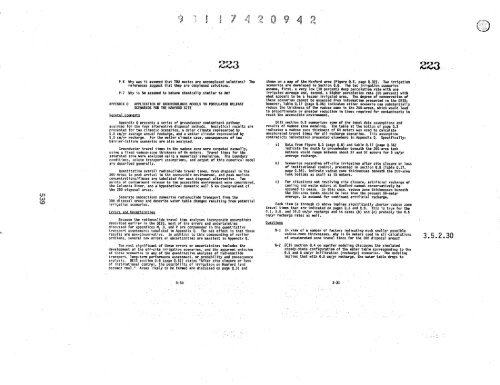EIS-0113_Section_11 - Hanford Site
EIS-0113_Section_11 - Hanford Site
EIS-0113_Section_11 - Hanford Site
Create successful ePaper yourself
Turn your PDF publications into a flip-book with our unique Google optimized e-Paper software.
# 4 a<br />
22.1 223<br />
P-6 Why was it assumed that TRU wastes are uncmnplexed solutions? The<br />
references suggest that they are complexed solutions.<br />
P-7 Why is Sm assumed to behave chemically similar to Am?<br />
APPENDIX Q APPLICATION OF GEOHYDROLOGIC MODELS TO POSTULATED RELEASE<br />
SCENARIOS FOR THE HANFORD SITE<br />
G<br />
shown on a map of the <strong>Hanford</strong> area (Figure Q.5, page Q.32). Two irrigation<br />
scenarios are developed in <strong>Section</strong> Q.8. The two irrigation scenarios<br />
assume, first, a very few (10 percent) deep percolation rate with one<br />
irrigated acreage and, second, a higher percolation rate (20 percent) with<br />
what appears to be a lesser irrigated area. The degree of conservatism of<br />
these scenarios cannot be assessed from infomation presented in the D<strong>EIS</strong>;<br />
however, Table Q.17 (page 0.36) indicates either scenario can substantially<br />
reduce the thickness of the Sateen zone in the 200-areas; which would lead<br />
to proportionate or greater reduction in times required for contaminants to<br />
reach the accessible environment.<br />
LIT<br />
W<br />
LO<br />
Appendix Q presents a series of groundwater contaminant pathway<br />
analyses for the four alternative disposal methods. Analytical results are<br />
presented for two climatic scenarios, a drier climate represented by<br />
0.5 cm/yr average`annual recharge, and a wetter climate represented by<br />
5.0 cm/yr recharge. For the wetter climate case, consequences of two<br />
barrier-failure scenarios are also analyzed.'<br />
Groundwater travel times in the vadose zone were computed manually,<br />
using a fixed vadose-zone thickness of 64 meters. Travel times for the<br />
saturated zone were analyzed using numerical simulation. The boundary<br />
conditions, solute transport assumptions, and output of this numerical model<br />
are described generally..<br />
Quantitative overall radionuclide travel times, from disposal to the<br />
200-Areas to peak arrival in the accessible environment, and peak nuclide<br />
concentrations/fluxes are tabulated for each disposal alternative. Two<br />
points of contaminant release to the accessible environment were considered,<br />
the Columbia River, and a hypothetical domestic well 5 km downgradient of<br />
the 200 disposal areas.<br />
Separate subsections summarize radionuclide transport from the<br />
300 disposal areas and describe water table .changes . resulting from potential<br />
irrigation scenarios. -<br />
LrrC E , and Uncertainties<br />
Because the radionuclide travel time analyses incorporate assumptions<br />
described earlier in the D<strong>EIS</strong>, most of the errors and uncertainties<br />
discussed for appendices M, 0, and P are Compounded in the quantitative<br />
trans p ort assessments tabulated in Appendix Q. The net effect is that these<br />
results are non-conservative. In addition to this compounding of earlier<br />
Problems, Several new errors or uncertainties are manifest in Appendix Q.<br />
D<strong>EIS</strong> section Q.3 summarizes some of the in p ut data assumptions and<br />
results of vadose zone modeling. The table at the bottom of page Q.3<br />
indicates a vadose zone thickness of 64 meters was used to calculate<br />
unsaturated travel times for all recharge scenarios. This assumption<br />
contradicts information presented elsewhere in Appendix Q. Specifically:<br />
a) Oat.. from figure 0.3 (page Q.8) and table 9.17 (page Q.36)<br />
.indicate the depth to groundwater beneath the 200-areatank<br />
bottoms would ran ge between about 37 and 57 meters for 5 cm/yr<br />
average recharge.<br />
b) Scenarios re garding off-site irrigation after site closure or loss<br />
of institutional control, presented in section Q.8 (Table Q.17,<br />
page 0.36), indicate vadose zone thicknesses beneath the 200-area<br />
tank bottoms as small as 15 meters.<br />
c) For situations not involving site closure,. artificial recharge of<br />
Coming and waste waters at <strong>Hanford</strong> cannot conservatively be<br />
assumed to cease.. In this case, vadose zone thicknesses beneath<br />
the 20D-area tanks should be less than the present 59-meter<br />
average, to account for continued artificial recharge.<br />
Each item (a through c) above implies significantly Shorter vadose zone<br />
travel times than are indicated on pages 0.3 and O.S. This is true for the<br />
0.1, 5.0, and 15.0 cm/yr recharge and in cases (b) and (c) probably the 0.5<br />
Cm/yr recharge. rates as well.<br />
Questions<br />
0-1 In view of a number of factors indicating much smaller possible<br />
vadose-zone thicknesses, why is 64. meters used in all calculations<br />
of unsaturated zone travel times for the 2OD disposal areas?<br />
3.5.2.30<br />
The most significant of these errors or uncertainties includes the<br />
development of the off-site irrigation scenarios, and the apparent omission<br />
of these scenarios in any of the quantitative analyses of radionuclide<br />
transport, long-term performance assessment, or probability and consequence<br />
analysis. D<strong>EIS</strong> section Q.8 (page Q.31) states "After site closure or less<br />
of institutional control, the passibility of irrigation on <strong>Hanford</strong> land<br />
becomes real.-Areas likely to be f rmed are discussed on page Q.31 and<br />
Q-2 .D<strong>EIS</strong> section Q.4 on aquifer modeling discusses the simulated<br />
steady-state configuration of the water table corresponding to the<br />
0.5 and 5 cm/yr infiltration (recharge) scenarios. The modeling<br />
implies that with 0.5 cm/yr recharge, the water table drops to<br />
3:30<br />
3-31

















